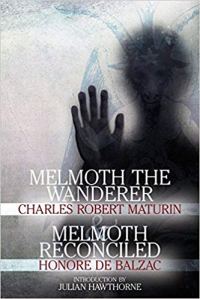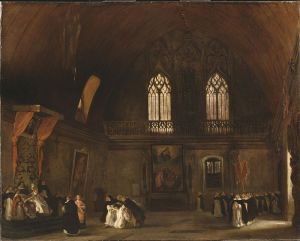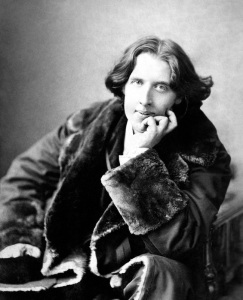Charles Maturin’s Melmoth the Wanderer will be celebrating its two hundredth anniversary next year, and it deserves to be celebrated since it is one of the most important Gothic novels of all time, yet few people who are not students of the Gothic have ever heard of it. Published in 1820, the novel was the most popular of the several novels Maturin, an Anglo-Irish and Anglican clergyman, published. It is also one of the last works from the Golden Age of Gothic Literature, ranging from roughly 1790 to 1820 when Radcliffe, Lewis, Shelley, and many other writers published notable Gothic novels. Most importantly, it had a huge influence on many other Irish and Gothic novels that followed it.

Charles Maturin (1780-1824) wrote several novels including historical fiction that predated Sir Walter Scott, whom he was friends with, and a popular tragedy, “Bertram.”
In this article, I will discuss a little about why Melmoth the Wanderer is an important Gothic novel, especially for its title Gothic wanderer figure and its anti-Catholicism, and then I will look at some of the other works it influenced.
Contribution to the Gothic Wanderer Figure and Anti-Catholicism
A good summary of Melmoth the Wanderer can be found at Wikipedia for those not familiar with the novel although I would encourage you to read it. Its stories-within-a-story technique, a common element of the Gothic, makes the reader wonder how all the stories will come together, but in the tale of Immalee, the full extent of Melmoth’s Gothic wanderer role is apparent. Melmoth is a member of an Irish family who in the seventeenth century was cursed and now wanders about Europe causing terror and tempting the innocent. He is not immortal, but he does have an extended life of about 170 years before he meets his fate at the end of the novel. Although he does try to tempt people, at times Melmoth feels torn with guilt, especially when he attempts to convince the innocent Immalee to marry him. Immalee was lost in childhood and has grown up alone in nature, innocent and childlike, but eventually, she is found and returned to her family in Spain. However, before Immalee is found, Melmoth visits her on the island and educates her in religion and other problems and hypocrisies of human society—or rather he miseducates her. After Immalee returns to Spain, Melmoth convinces her to marry him in a dark ceremony, and then she conceives his child. When her brother accosts Melmoth, Melmoth slays him and Immalee nearly dies from grief. She is then taken to the prisons of the Inquisition where she gives birth to a daughter. Because of her sin for loving a minion of Satan, she is condemned to lifetime imprisonment in the Inquisition’s prison, and her child is to be taken from her and raised in a convent. However, the child dies before it can be taken from its mother and Immalee dies soon after.
Although the novel was written by an Irishman, it’s important to note that Maturin had a low opinion of Catholics and was himself Anglican. The novel is the most extreme example of anti-Catholicism of all the Gothic novels I have read. Much of the novel is the story of Moncada, who is forced by his family members—themselves manipulated by the clergy—to enter a seminary and become a priest. Because he resists, Moncada is beaten, tortured, and locked up in a cell without light. The depiction of the Inquisition is overall very derogatory. Not that the Inquisition was not a horrible institution, but Maturin has no problem with depicting it in the most derogatory way possible, likely without any real knowledge of the institution.
A Sequel by Honoré de Balzac

This edition of Melmoth the Wanderer includes Balzac’s sequel, and an introduction by Julian Hawthorne, the son of Nathaniel Hawthorne, who referenced Melmoth in his 1828 novel “Fanshawe.”
At the novel’s conclusion, Melmoth’s prolonged life appears to end. However, because no one witnesses Melmoth’s death and there is no final body, the possibility exists that he lives on. Melmoth may not have died since it is believed that Maturin intended a never-written sequel in which Melmoth would return. Honoré de Balzac did write a sequel, Melmoth Reconciled (1835), in which Melmoth is able to find someone to take his place and thereby rest from his wanderings. This short sequel is lacking in Gothic atmosphere and effectiveness, but Balzac does retain the concentration upon Melmoth’s eyes which create a “piercing glance that read men’s inmost thoughts.” The French work is also progressive compared to British Gothic in that it allows the Gothic wanderer to rest, which would be denied to Gothic wanderers in British fiction until the Victorian period.
Influence of Melmoth the Wanderer on J. S. Le Fanu and James Joyce
In rereading Melmoth the Wanderer, I noticed many aspects and possible influences it may have had on literature that I had failed to notice previously when I wrote about it in The Gothic Wanderer. First is the opening scenes where John Melmoth comes to his uncle’s deathbed. This scene is written in a tongue-in-cheek, lighthearted, and comical manner, despite the gravity of the situation. The manuscript John Melmoth reads that depicts life at the court of Charles II is also of this style. What surprised me was that these pages seem like they could have come straight out of J. S. Le Fanu’s The House by the Churchyard (1863). I’ve always thought that particular novel of Le Fanu’s to be almost unreadable, but the comical tone is very similar, suggesting that Le Fanu must have read Maturin. Notably, James Joyce is said to have been inspired by Le Fanu’s novel in writing Finnegan’s Wake (1939).
However, the influence of Maturin on Joyce is even more specific. In Chapter 14 of Ulysses (1922), titled “Oxen of the Sun,” Joyce uses a variety of literary styles that basically trace the history of the English language. One section of the chapter, lines 1010-1037, is written as a parody of Gothic novels, as scholars have long noted. Don Gifford’s Ulysses Annotated even notes that this parody owes a debt to Le Fanu’s The House by the Churchyard.
Note the similarity between this passage from “Oxen of the Sun” and the following one from Melmoth the Wanderer:
“The secret panel beside the chimney slid back and in the recess appeared…Haines! Which of us did not feel his flesh creep? He had a portfolio full of Celtic literature in one hand, in the other a phial marked Poison. Surprise, horror, loathing were depicted on all faces while he eyed them with a ghastly grin.”
In the penultimate paragraph of Chapter 1 of Melmoth the Wanderer, John Melmoth first sees Melmoth the Wanderer as follows:
“At this moment, John saw the door open, and a figure appear at it, who looked round the room, and then quietly and deliberately retired, but not before John had discovered in his face the living original of the portrait. His first impulse was to utter an exclamation of terror, but his breath felt stopped.”
John is shocked because he has already heard that Melmoth the Wanderer has lived well over a century and seen the portrait of this relative. The two passages are not obviously the same, but the entrance of a figure who causes shock occurs in both, and I suspect Joyce borrowed it from Maturin, whether consciously or not. Since Maturin was an Irish writer, Joyce was likely familiar with his work, though I am not aware of any scholars discussing Maturin’s influence on him, something that should be explored further.
Influence on George W. M. Reynolds

This painting by Eugene Delacroix is titled “Melmoth or Interior of a Dominican Convent.” It depicts Moncada being mistreated by the other monks for wanting to renounce his vows.
George W. M. Reynolds was the bestselling author of Victorian England and a key player in the Gothic renaissance that occurred in the 1840s and 1850s with the rise of the penny dreadful. One of Reynolds’ novels, The Necromancer (1851-2), tells the story of a man who has a bargain with the devil to marry seven women over the course of a couple of centuries so that they sell their souls to Satan; if he fails, his own soul will be lost. The plot of Reynolds’ novel recalls Melmoth’s effort to deceive Immalee into marrying him and agreeing to follow his God (Satan), although she never completely understands his purposes. That she ends up dead, and in the final scene of the novel, Melmoth is taken by the devil suggests that perhaps Melmoth had a similar pact with Satan. Maturin does not say this overtly, but Reynolds might well have read the novel, read between the lines, and expanded on the idea in his own book. Since so little is known about Reynolds, we do not know if he read Maturin’s novel or not, but it seems plausible given that he was obviously well-versed in the Gothic tradition.
Influence on Anthony Trollope
Scholars have not failed to note that the villain in one of Anthony Trollope’s greatest novels, The Way We Live Now (1875) is named Melmotte, a name that may owe a debt to Maturin’s Melmoth. Besides the name similarity, there is much confusion and many rumors about exactly who Melmotte is in Trollope’s novel. He is suspected of being Jewish because he is in finance, but beyond this, he is known for having lived in various locations—a type of wandering that makes him akin to the Wandering Jew, whose legend was a major influence on the creation of Melmoth the Wanderer. Among the possible backgrounds of Melmotte is also that he is Irish—his father believed to be an Irish coiner in New York named Melmody (Chapter 98), from whom Melmotte may have learned forgery. Melmotte, of course, claims he is English, wanting to rise in English society.
Since Trollope spent considerable time in Ireland, it is not surprising that he was likely familiar with this Irish novel, which would have been quite popular in his childhood. Coincidentally, Trollope worked for the Post Office in Ireland and Maturin’s father was a Post Office official.
Influence on Edward Bulwer-Lytton and Charles Dickens
Edward Bulwer-Lytton’s novel Zanoni (1842) is noteworthy for how it reversed the Gothic tradition by creating positive depictions of Rosicrucian characters with extended lives. (For a full discussion of Zanoni and Rosicrucianism in the Gothic tradition see my book The Gothic Wanderer.) Notably, Rosicrucians were known for life-extension and so Melmoth the Wanderer may have been influenced by the Rosicrucian tradition, which had already influenced other earlier novels such as Percy Shelley’s St. Irvyne (1811). (Notably, George W. M. Reynolds’ novel Wagner the Wehr-Wolf (1846-7) features the Rosicrucian founder, Christian Rosencrux, as a character.) Bulwer-Lytton may have been influenced specifically by the end scenes of Melmoth the Wanderer when Immalee is imprisoned by the Inquisition and gives birth to a child who dies. In Zanoni, Bulwer-Lytton’s title character is a Rosicrucian who has lived a long life. He and his lover, Viola, are caught up in the chaos of the French Revolution, resulting in Viola giving birth to their child in prison. Melmoth dies long after Immalee when Satan comes to take him, but Zanoni ends up dying at the guillotine. However, hope remains in the image of the child born to Viola, who survives.
Notably, Zanoni was a major influence on Dickens’ A Tale of Two Cities (1859), particularly Sidney Carton’s sacrifice at the end of the novel, but also because of its many Rosicrucian elements, as discussed in my book The Gothic Wanderer. Therefore, Melmoth the Wanderer may be said to be the grandfather of Dickens’ novel.
Influence on Oscar Wilde

Oscar Wilde was Charles Maturin’s great-nephew by marriage and adopted the name Sebastian Melmoth to protect his privacy and comment upon his state as an outcast following his famous trial and prison term.
It is well-known, but worth repeating, that Maturin was the uncle by marriage to Oscar Wilde’s mother. After Wilde was released from prison after serving a sentence for homosexuality, Oscar Wilde adopted the name of Sebastian Melmoth while he wandered about Europe. The name Melmoth implied he was cursed and a wanderer, and the name Sebastian referenced St. Sebastian, considered the first gay icon of the nineteenth century.
Numerous Other Influences
Melmoth the Wanderer influenced many other literary works in direct and indirect ways and has even influenced the creation of characters in movies and TV. The following list comes from Wikipedia, which includes a few of the works I have already mentioned:
- In Arturo Pérez-Reverte’s The Club Dumas (the basis for Roman Polanski’s film The Ninth Gate), Corso bumps into the mystery girl following him as she is reading Melmoth the Wanderer in the lobby of the hotel after seeing Fargas to review his copy of The Nine Doors of the Kingdom of Shadows.
- In Nathaniel Hawthorne’s Fanshawe, one of the major characters is named “Doctor Melmoth.”
- In Vladimir Nabokov’s Lolita, Professor Humbert Humbert calls his automobile “Melmoth.”
- In John Banville’s 1989 novel The Book of Evidence, the narrator steals an automobile from a garage called “Melmoth’s”; the make of the car is a Humber, an allusion to both Wilde and Nabokov.
- “Melmoth” is mentioned in Alexander Pushkin’s Eugene Onegin.
- In Dave Sim’s Cerebus comic book (issues 139–150), there’s a writer named Oscar (homage to Oscar Wilde), who’s registered under the name “Melmoth” at his hotel.
- In Grant Morrison’s Seven Soldiers metaseries, Melmoth is an antagonist of Frankenstein.
- In Leonie Swann’s Three Bags Full: A Sheep Detective Story, the mysterious sheep who has wandered the world and comes home to teach the flock what he has learned is named Melmoth.
- The mysterious financier Augustus Melmotte in Anthony Trollope’s The Way We Live Now resembles Melmoth in more than name.
- In an 1842 review of Stanley Thorn, Edgar Allan Poe refers to “the devil in Melmoth” as an ineffectual seducer of souls.
- In letters P. Lovecraft addresses Donald Wandrei as Melmoth the Wandrei.
- A British magazine about surrealism was named Melmoth after the book. Melmoth was published from 1979-1981 and its contributors included George Melly and Ithell Colquhoun.
- In the British TV murder mystery series Midsomer Murders the episode “Murder By Magic” (2015) included a mysterious country manor called Melmouth House, the home of an infamous rake-hell and paganist, Sir Henry Melmouth, who died, apparently, in a ritual pagan fire, hoping to be reborn from the ashes like the mythical phoenix.
- In Marty Feldman’s movie In God We Tru$t (1980), Peter Boyle plays a con man and crooked street preacher named Dr. Sebastian Melmoth.
- Peter Garrison named the aircraft Garrison Melmoth after himself and Melmoth the Wanderer.
- Sarah Perry’s third novel Melmoth (2018) centers on a female variation of Maturin’s character, damned (like Richard Wagner’s Kundry in Parsifal) for denying the resurrection of Jesus Christ.
The reason I recently decided to reread Melmoth the Wanderer was because I had heard about Sarah Perry’s new novel Melmoth. I will be reviewing that novel in my next article.
Even though Melmoth the Wanderer’s life appears to end at the conclusion of Maturin’s novel, it is clear his influence wanders on and likely will continue to do so for many years to come.
___________________________________________________
Tyler Tichelaar, PhD, is the author of King Arthur’s Children: A Study in Fiction and Tradition, The Gothic Wanderer: From Transgression to Redemption, The Children of Arthur novel series, Haunted Marquette: Ghost Stories from the Queen City and numerous other books. Visit Tyler at www.ChildrenofArthur.com and www.GothicWanderer.com.

I didn’t know that Maturin was Wilde’s mother’s uncle or that Wilde adopted the name Sebastian Melmoth or that St. Sebastian was supposedly gay. All very interesting.
Diane, thank you for the comment. I’m not sure the suggestion is that St. Sebastian is gay. It was the popular image of his largely naked body pierced with arrows that was seen as erotic by gay men, as I understand it.
First, thank you for that solid blog-article, Tyler.
This is not meant to discourage anyone but I’ll say first I’ve tried to read the book more than once, but find it too long and involved — in a way I am reminded of the very long Nievo’s The Confessions of An Italian — written around the same time.
Epic books.
That said, what I did – and have read about the book – makes it fascinating. I find your summary of all the books influenced very useful. I’ve not read most of the books cited. To my mind the gothic until more recently subdivides into female versus male, terror versus horror (the first tends to spiritual shattering, the second breaking all body taboos), and also reactionary versus radical (politically). Now it’s all over the place in its connections, what it subsumes and is found in too.
Melmotte name and type became one of these mythic icons. So we go from Trollope’s corrupt crude financier to Oscar Wilde ….
Ellen
Pingback: Sarah Perry’s Melmoth: A Modern Spin-Off of Maturin’s Classic Gothic Novel Melmoth the Wanderer | The Gothic Wanderer
Pingback: Ivanhoe: Sir Walter Scott’s Bridge from the Gothic to Realism | The Gothic Wanderer
Pingback: Anne of Geierstein: Sir Walter Scott’s Most Gothic Novel | The Gothic Wanderer
Pingback: The Husband as Horror: Charlotte Smith’s Montalbert | The Gothic Wanderer
Pingback: A Review of the Essay Collection Gothic and Racism | The Gothic Wanderer
Pingback: William Harrison Ainsworth: Father of the Second Gothic Golden Age | The Gothic Wanderer
Pingback: Robert Macaire, Reformed Gothic Transgressor | The Gothic Wanderer
Pingback: Longsword: Contender for First Historical and Gothic Novel | The Gothic Wanderer